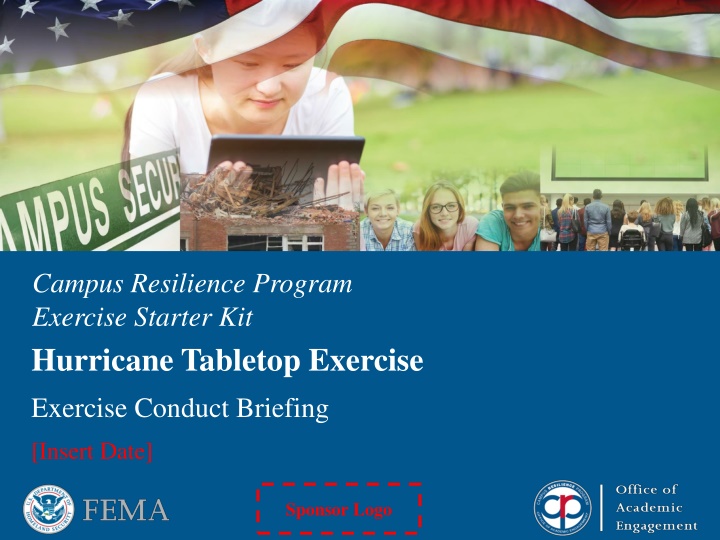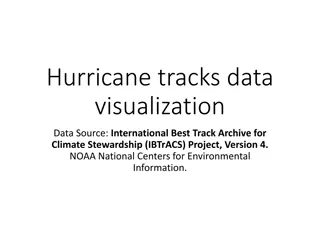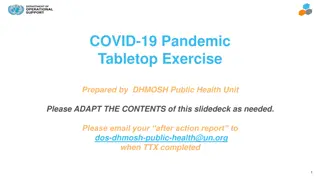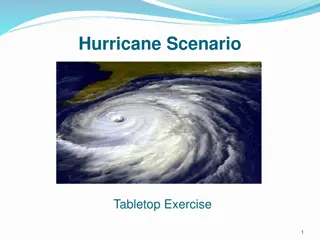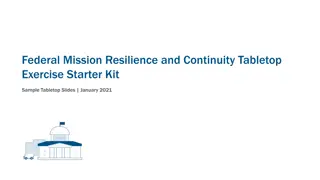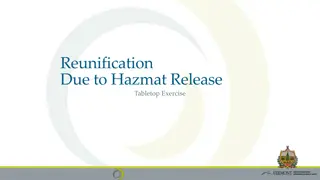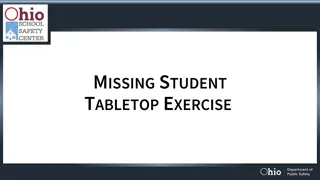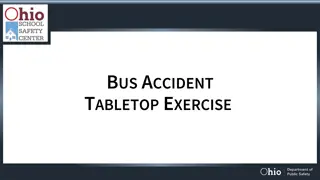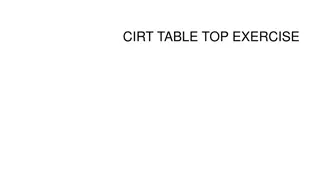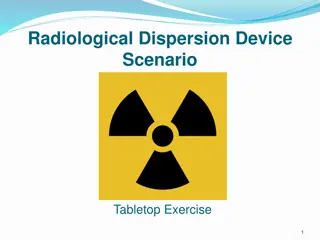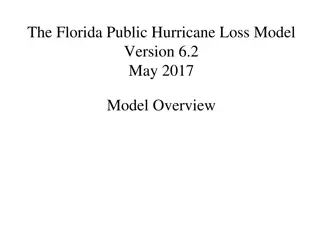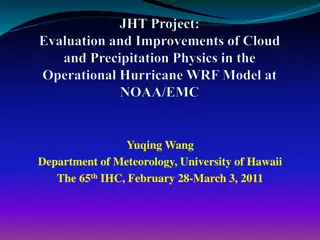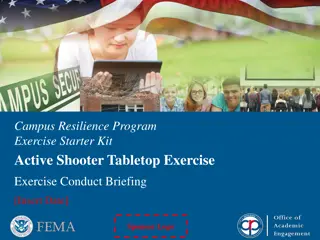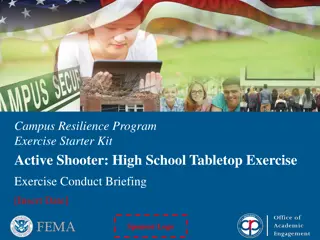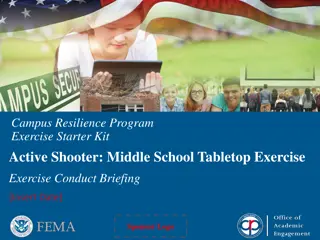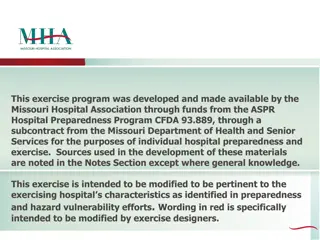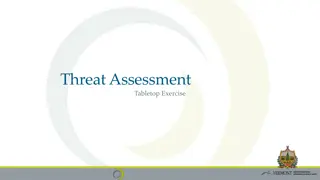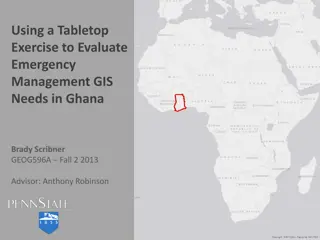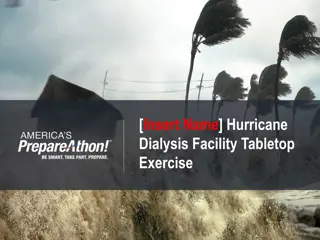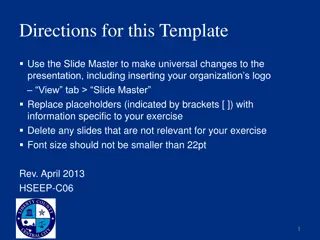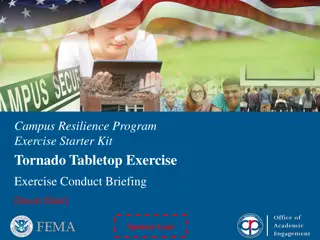Campus Resilience Program Exercise Starter Kit - Hurricane Tabletop Exercise
This Exercise Conduct Briefing provides a baseline document for higher education institutions to evaluate their emergency plans. Tailor the content as needed by filling in bracketed sections. It is to be used with the Hurricane Situation Manual and Facilitator Guide. The briefing covers Welcome and Introductions, Administrative Remarks, Exercise Schedule, and Exercise Overview for a tabletop exercise focusing on hurricane preparedness, response, and recovery operations.
Download Presentation

Please find below an Image/Link to download the presentation.
The content on the website is provided AS IS for your information and personal use only. It may not be sold, licensed, or shared on other websites without obtaining consent from the author.If you encounter any issues during the download, it is possible that the publisher has removed the file from their server.
You are allowed to download the files provided on this website for personal or commercial use, subject to the condition that they are used lawfully. All files are the property of their respective owners.
The content on the website is provided AS IS for your information and personal use only. It may not be sold, licensed, or shared on other websites without obtaining consent from the author.
E N D
Presentation Transcript
Campus Resilience Program Exercise Starter Kit Hurricane Tabletop Exercise Exercise Conduct Briefing [Insert Date] Sponsor Logo Sponsor Logo
READ FIRST The purpose of this Exercise Conduct Briefing is to provide a baseline exercise document that institutions of higher education can use to assess their emergency plans, policies, and procedures The sample content contained in this document can be tailored as necessary by filling in all [bracketed content that is highlighted in red] To insert the sponsoring organization s logo, navigate to the View menu and select Slide Master This briefing is to be used in tandem with the Hurricane Situation Manual and Facilitator Guide so any changes made to this briefing will need to be aligned with those documents **Delete slide prior to conduct**
Welcome and Introductions [Name] [Title] [Department/Agency/Organization] [Name] [Title] [Department/Agency/Organization] Sponsor Logo 3
Administrative Remarks Cell phone etiquette Evacuation procedures Restroom locations Sponsor Logo 4
Exercise Schedule Activity [Welcome and Introductions] [Exercise Overview] Module 1: Preparedness Break Module 2: Response Break Module 3: Short-Term Recovery [Exercise Hot Wash] [Closing Remarks] Time [00:00 a.m.] [00:00 a.m.] [00:00 a.m.] [00:00 a.m.] [00:00 p.m.] [00:00 p.m.] [00:00 p.m.] [00:00 p.m.] [00:00 p.m.] Sponsor Logo 5
Exercise Overview Sponsor Logo 6
Exercise Overview Background: This Tabletop Exercise (TTX) is made available through the Campus Resilience (CR) Program Exercise Starter Kits Each Exercise Starter Kit aims to support practitioners and senior leaders from the academic community in assessing emergency plans, policies, and procedures while also enhancing overall campus resilience Purpose: This specific Exercise Starter Kit will provide the opportunity to examine preparedness, response, and recovery operations related to a hurricane Sponsor Logo 7
Exercise Overview (cont.) Scope: This [insert duration]-TTX is divided into three Modules: Module 1 will examine preparedness operations leading up to a hurricane Module 2 will examine response efforts once a hurricane makes landfall Module 3 will examine short-term recovery operations following a hurricane Each Module will consist of two activities: 1. Scenario Overview: Each Module will contain a detailed overview of the scenario 2. Facilitated Discussions: Participants will engage in facilitated discussions surrounding a set of discussion questions Sponsor Logo 8
READ FIRST The exercise objectives contained in the following slide(s) are provided as sample objectives These can be tailored as appropriate to align with the overarching goals and desired outcomes for the exercise Please note that changes made to these objectives will need to be reflected in the associated Facilitator Guide and Situation Manual for this scenario **Delete slide prior to conduct**
Exercise Objectives 1. Operational Coordination: Assess the ability to establish an effective command structure that integrates all critical stakeholders to ensure campus and community resources are used efficiently to prepare for, respond to, and recover from a hurricane impacting campus operations Mass Care Services: Examine the ability to provide life-sustaining and human services to affected populations at your institution to include hydration, feeding, sheltering, temporary housing, evacuee support, reunification, and distribution of emergency supplies Infrastructure Systems: Evaluate the ability to protect, restore, and revitalize your institution s critical infrastructure systems and assets to minimize threats to health and safety Public Information and Warning: Assess the ability to deliver coordinated, actionable, and timely information to critical partners and stakeholders when faced with a hurricane impacting campus operations 2. 3. 4. Sponsor Logo 10
Participant Roles and Responsibilities Facilitator: Provides situation updates and facilitates discussions Players: Respond to the situation presented based on current plans, policies, and procedures Observers: Visit or view selected segments of the exercise without directly engaging in exercise discussions Support Staff: Performs administrative and logistical support during the exercise (e.g., registration) [Insert additional participant roles as appropriate] Sponsor Logo 11
Participating Organizations [Insert Participating Organization] [Insert Participating Sub-Organization] [Insert Participating Organization] [Insert Participating Sub-Organization] [Insert Participating Organization] [Insert Participating Sub-Organization] Sponsor Logo 12
Exercise Guidelines This exercise is being conducted in an open, low-stress, no-fault environment; varying viewpoints, even disagreements, are expected Act in real-world roles for your institution or organization when considering the scenario Decisions are not precedent-setting; this is an open discussion The focus should be on identifying suggestions and recommended actions for improving preparedness, response, and recovery efforts [Insert any additional guidelines that may be relevant to the exercise] Sponsor Logo 13
Assumptions and Artificialities The exercise scenario is plausible and events occur as they are presented Players will use existing plans, policies, procedures, and resources to guide responses There is no hidden agenda nor are there any trick questions The scenario assumes certain player actions as it moves through each phase; players should first discuss the actions stipulated by the scenario Players are welcome to engage in what if discussions of alternative scenario conditions [Insert any additional assumptions or artificialities that may be relevant to the exercise] Sponsor Logo 14
Start of Exercise Sponsor Logo 15
Module 1: Preparedness Sponsor Logo 16
Module 1: Scenario Overview [Insert Date and Time; 72 Hours Before Landfall] A Category 2 hurricane is tracking towards your area Hurricane track models from the National Hurricane Center indicate the storm will make landfall in your area The National Weather Service warns that your area will suffer heavy rainfall, high winds, and flooding; a hurricane watch is issued Families of students at your institution begin to reach out asking how your institution will protect student health and welfare Sponsor Logo 17
Module 1: Scenario Overview (cont.) [Insert Date and Time; 24 Hours Before Landfall] Other institutions in your area begin cancelling classes, athletic events, and social functions Faculty and students express concern over the impact of potential power outages on their research equipment and lab materials Sponsor Logo 18
Module 1: Discussion Questions (1/4) Operational Coordination 1. What plans, policies, and procedures does your institution have in place to prepare for an approaching hurricane? 2. What are your institution s initial priorities? 3. How would your institution establish a command structure to coordinate your preparedness efforts? 4. What resource gaps could limit your institution s ability to prepare for a hurricane? 5. [Insert additional discussion questions as appropriate] Sponsor Logo 19
Module 1: Discussion Questions (2/4) Mass Care Services 1. What plans, policies, and procedures does your institution have in place to mitigate the disruption of essential campus services? 2. What risks does a hurricane pose to your institution s facilities? 3. Is your institution equipped to serve as an emergency shelter? 4. What are your institution s plans, policies, and procedures for conducting an evacuation? 5. [Insert additional discussion questions as appropriate] Sponsor Logo 20
Module 1: Discussion Questions (3/4) Infrastructure Systems 1. What risks does a hurricane pose to your institution s key infrastructure (e.g., campus facilities)? 2. What steps can your institution take to protect your critical infrastructure? 3. What plans, policies, and procedures does your institution have in place to mitigate a temporary loss off critical infrastructure? 4. [Insert additional discussion questions as appropriate] Sponsor Logo 21
Module 1: Discussion Questions (4/4) Public Information and Warning 1. What plans, policies, and procedures does your institution have in place to guide your internal and external communications strategies? 2. How and when does your institution issue warnings, alerts, and other emergency messaging? 3. What individual, office, or department coordinates and delivers your institution s public messaging? 4. How does your institution encourage students, faculty, and staff to take individual steps to mitigate the potential impacts of a hurricane? 5. How will your institution use social media platforms in support of incident communications and public messaging? 6. [Insert additional discussion questions as appropriate] Sponsor Logo 22
Break Sponsor Logo 23
Module 2: Response Sponsor Logo 24
Module 2: Scenario Overview (1/3) [Insert Date and Time; Landfall] The hurricane makes landfall as a Category 1 storm Roadways are flooded and trees have fallen, causing power outages across campus Hurricane-force winds and broken branches damage multiple academic and administrative buildings Flood affects several first-floor student housing facilities Sponsor Logo 25
Module 2: Scenario Overview (2/3) [Insert Date and Time; 36 Hours After Landfall] The hurricane weakens to a tropical storm Your institution received 10 inches of rain and experienced winds of up to 75 mph Utility companies estimate that power outages will continue for 3 to 5 days Local officials warn people not to drink the public water, which might have become contaminated during the storm Law enforcement provides notification of curfews and road closures Sponsor Logo 26
Module 2: Scenario Overview (3/3) [Insert Date and Time; 48 Hours After Landfall] Multiple students and members of staff suffered fatal injuries in the storm and several dozen students are hospitalized Some faculty members and students remain unaccounted for, including some international students Local media reports on the hurricane-related fatalities spark an influx of calls and emails from anxious families Sponsor Logo 27
Module 2: Discussion Questions (1/4) Operational Coordination 1. What plans, policies, and procedures does your institution have in place to guide response efforts? 2. How would your institution establish and maintain an effective command structure to coordinate emergency response efforts? 3. How do key decision-makers collect information on damages and critical needs? 4. What resources are currently available? 5. Who are the key external stakeholders that would support response efforts? 6. [Insert additional discussion questions as appropriate] Sponsor Logo 28
Module 2: Discussion Questions (2/4) Mass Care Services 1. What plans, policies, and procedures does your institution have in place to ensure the life safety and health of all students, faculty, and staff? 2. What resource gaps could limit your institution s ability to provide mass care services? 3. What emergency housing plans, policies, and procedures does your institution have in place? 4. What resource gaps could limit your institution s ability to meet your community s emergency housing needs? 5. [Insert additional discussion questions as appropriate] Sponsor Logo 29
Module 2: Discussion Questions (3/4) Infrastructure Systems 1. How will your institution facilitate the speedy restoration of critical infrastructure systems and services? 2. How would your institution coordinate the restoration of critical infrastructure? 3. What mechanisms does your institution implement to ensure continuity of operations during this response period? 4. How does your institution collect real-time updates on the status of its critical infrastructure? 5. [Insert additional discussion questions as appropriate] Sponsor Logo 30
Module 2: Discussion Questions (4/4) Public Information and Warning 1. How does your institution ensure consistent and coordinated public messaging throughout the initial response period? 2. How does your institution ensure timely and accurate situational updates for internal stakeholders throughout the response period? 3. Does your institution have a crisis communications plan or other means of communicating with all stakeholders in case of a breakdown of standard communications? 4. How does your institution notify families, key stakeholders, and the public of fatalities or serious injuries? 5. [Insert additional discussion questions as appropriate] Sponsor Logo 31
Break Sponsor Logo 32
Module 3: Short-Term Recovery Sponsor Logo 33
Module 3: Scenario Overview [Insert Date and Time; Three Days After Landfall] The storm has dissipated Roadways around your institution remain partially flooded and clogged with debris, causing accidents Your campus is still without power and multiple campus buildings require repair Some student housing remains uninhabitable Sponsor Logo 34
Module 3: Scenario Overview (cont.) [Insert Date and Time; One Week After Landfall] Students inquire about how class cancellations will impact their academic schedules and financial requirements Families of international students reach out to embassies and consulates to see how class cancellations will impact their children s immigration status Sponsor Logo 35
Module 3: Discussion Questions (1/4) Operational Coordination 1. How does your institution coordinate the transition from response to short-term recovery efforts? 2. What plans, policies, and procedures guide your institution s recovery process? 3. What resource gaps could limit your institution s ability to meet these priorities? 4. How well is your institution s finance team prepared to process and submit FEMA claims? 5. [Insert additional discussion questions as appropriate] Sponsor Logo 36
Module 3: Discussion Questions (2/4) Mass Care Services 1. What plans, policies, and procedures does your institution have in place to return your campus to a healthy and safe environment? 2. What long-term housing plans, policies, and procedures does your institution have in place? 3. What resource gaps could limit your institution s ability to meet your community s long-term housing needs? 4. [Insert additional discussion questions as appropriate] Sponsor Logo 37
Module 3: Discussion Questions (3/4) Infrastructure Systems 1. Which infrastructure systems would your institution prioritize during the recovery period? 2. How would your institution coordinate the complete restoration of critical infrastructure? 3. What mechanisms does your institution have in place to maintain continuity of operations throughout the recovery period? 4. [Insert additional discussion questions as appropriate] Sponsor Logo 38
Module 3: Discussion Questions (4/4) Public Information and Warning 1. How does your institution ensure consistent, coordinated public messaging throughout the recovery period? 2. How does your institution provide internal stakeholders with timely updates concerning recovery efforts? 3. Who is responsible for monitoring and managing inquiries from affected students, faculty, staff, and alumni? 4. [Insert additional discussion questions as appropriate] Sponsor Logo 39
End of Exercise Sponsor Logo 40
Exercise Hot Wash Sponsor Logo 41
Hot Wash Overview This Hot Wash aims to capture the following information based on observations made throughout the exercise: Overall strengths Overall areas for improvement Major takeaways and action items Sponsor Logo 42
Closing Remarks [Name] [Title] [Department/Agency/Organization] [Name] [Title] [Department/Agency/Organization] Sponsor Logo 43
Adjournment Sponsor Logo 44
Campus Resilience Program Exercise Starter Kit Hurricane Tabletop Exercise Exercise Conduct Briefing [Insert Date] Sponsor Logo Sponsor Logo
